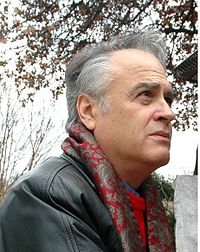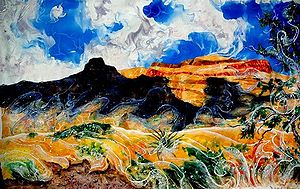- Donray
-
Not to be confused with Nautical painter Don Ray.
Donray 
Artist Donray in January, 2009Born July 29, 1945
Houston, TexasNationality American Field Painter (Acrylics and Pastels) Movement Post-Modern Expressionism Influenced by Expressionists, Futurists, Fauves Influenced Acrylic-on-Acrylic collage technique Donray (born Donald Arvin Ray, July 29, 1945) is a contemporary American artist in the style of Post-Modern Expressionism with elements of Surrealism, Futurism and Fauvism.[1]
He is known for metaphorical imagery exploring the dynamic nature of life and the human desire for spiritual enlightenment and fulfillment.[1]
Donray subjects include figures, objects and landscapes in motion, and methods include acrylic on various media including Masonite, paper, canvas, and drawings in charcoal, conte crayon, and color pastels. His works have been collected by a number of notable people and entities.
Donray might be best known for an innovative technique he uses in his acrylic works, a technique he has pioneered. It involves an acrylic-on-acrylic collage created by the artist. The collage material is the same as that being used to paint with, and developed through a tedious process of mixing, pouring, manipulation and cutting. The result is a dramatic display of intermingling color, texture, depth, reflecting light and energy.
Contents
Background
Early Life and Development as an Artist
Donray was born Donald Arvin Ray in Houston, Texas, July 29, 1945. He showed an interest in art at an early age and learned to draw from his mother. After service in the U.S. Marine Corps in Vietnam, he studied law at Baylor University and also studied painting privately while in law school. He lived and worked in East Texas until 1989 when he moved to Dallas living in the colorful Deep Ellum section of that city (1990–1993).
In 1993 Donray moved to New York, locating first in the DUMBO area of Brooklyn and later moving to Manhattan, maintaining a studio on 14th Street near 7th Avenue on the border between Greenwich Village and Chelsea. While in New York, he became friends with artists Knox Martin, Norman Bluhm, Mel Chin and Irv Tepper, and critic and museum curator, James Harithas. He also was friends with industrial music pioneer J.G. Thirlwell of Foetus (band), whose portrait he painted. Donray regularly attended the lectures of Knox Martin at the Art Students League of New York, and was so impressed that Martin became a trusted and reliable mentor to the artist. Many consider Donray's New York years as his formative period. Six years later in 1999, Donray returned to Texas.
Critical Success and Mainstream Following
In the late '90s and early 2000s Donray slowly built a critical following for his work. Some of Donray's best-known works to date were created in this period, including: the acrylic-on-canvas paintings "Woman in a Boat" and "Sanctuary" (both in the Allegiance Capital collection)[2] and "Trouble in the Chute," purchased by billionaire Bob McNair, a businessman, philanthropist and owner of the Houston Texans National Football League team who is ranked #321 on the 2008 Forbes 400 Richest Americans.[3] The work hangs at Reliant Stadium in Houston. Also, Johnny Depp, the Academy Award-nominated and Golden Globe-winning actor, is reported to have purchased the Donray painting "Fandancer."[4]
In early 2009, his works received increasing mainstream popularity and attention, signified by the announced February purchase of a broad cross-section of his works by Allegiance Capital Corporation, an investment-banking firm.[4] In April, Prestige Financial Center, a financial services company, also purchased three of his works.[5]
Work & Technique
As an artist, Donray describes himself as "fiercely independent" in both his work and his influences, and as such has been influenced not only by Expressionism, Futurism, Surrealism and Fauvism, but also by movements including Baroque, Romanticism, and German Expressionism. His work is described by critics and other artists as “fierce,” “at once raw and refined” (Donald Kuspit); “vertiginous and confrontational” (Knox Martin); “figurative, abstract and American” (Edward Lucie-Smith); “complex and luminous” (Ruth Bass); and “vibrant with near violent colors” (Harold Rubin, The Rivington Gallery, London, UK).
Donray emphasizes color and motion, and he regularly experiments with various unique techniques using acrylics and pastels. His innovative technique in his acrylic works, a technique he pioneered, involves an acrylic-on-acrylic collage created by the artist. Unlike the collage material used by other artists, Donray uses the same material as what is being used to paint with, and develops it through a tedious process of mixing, pouring, manipulation and cutting. This involves the use of glazing and under painting, the use of lines and gestural brush strokes to define shapes in masses of swirling color, and the use of layers of translucent glaze dried separately from the painting. He also uses pouring and dripping and splattering methods of applying paint as well manipulating it on the surface with pieces of cardboard rather than brushes. Many early paintings were completed on Masonite, but he moved exclusively to canvas while living in New York. His technique in the use of pastels involves rubbing and smudging the material into the surface of paper and drawing images with a kneaded eraser.
Critical Analysis
The works of Donray have, as a central vibration, major rhymes of his physiognomy that are like dashes of pique reflecting off encounters of the wondrous with excitement in hustling technique that is masterfully appropriate for his motif of luminous and vertiginous confrontations. What a rush!—Knox Martin, NY Abstract Expressionist.[1]The paintings demonstrate an inverted approach; gentle and focused at the same time being super-macho and withdrawn. Viewers are invited to draw near but not to intrude on the artist’s thoughts…—Edward Lucie-Smith, International Art Critic.[1]There is a verve, an energy, a dynamic surging gesture, violent movement, an overall vividness and vitality – that places Donray’s paintings among the most interesting of what might be called post-modern expressionist painting.—Donald Kuspit, American art critic, poet, and professor.[1]Bibliography
- John Austin “A Vocation Years in the Making,” Fort Worth Star-Telegram, Fort Worth, July 29, 2000
- Ruth Bass DONRAY, Visual Prayer, essay for exhibition catalogue, Klara Kohl Gallery, New York, 1998.
- Ruth Bass “New York? New York!” Art-Talk, Vol. XXII, Number 1, Scottsdale, Arizona, 1998
- Nan Coulter “HP Goes to a Party,” Dallas Morning News, Dallas, January 23, 2000
- Donald Kuspit Donray and Expressionism, essay for exhibition catalogue, So Hyun Gallery, New York, 2000.
- Donald Kuspit, Ruth Bass, Dominic Luytens "Donray, A Cross-Section," Reprint of essays from previous catalogues for exhibition catalogue, Arlington Museum of Art, Arlington, Texas, 2008.
- Edward Lucie-Smith Statement for exhibition catalogue, The Rivington Gallery, Ltd., London 1999.
- Knox Martin DONRAY, A statement, Klara Kohl Gallery, New York, 1998
- Harold Werner Rubin Statement for exhibition catalogue, The Rivington Gallery, Ltd., London 1999.
- Marcus Skiersky DONRAY, essay in exhibition brochure, V. Brooks Gallery, Dallas, 1989 (Reprinted in X-POSE.)
- Angie Summers “Out and About in Arlington,” Fort Worth Star-Telegram, Fort Worth, January 19, 2000.
- Vicki Thacker “Donray, an interview”, XPOSE, Dallas, 1991.
Exhibitions
Dealers
Donray has dealers in New York, London, and in the Dallas/Fort Worth area where he works and resides.[6]
References
- ^ a b c d e Biography
- ^ [1]
- ^ [2]
- ^ a b [3]
- ^ http://www.reuters.com/article/pressRelease/idUS172905+27-Apr-2009+BW20090427
- ^ Donray Representation
External links
Categories:- American painters
- 1945 births
- Living people
Wikimedia Foundation. 2010.

